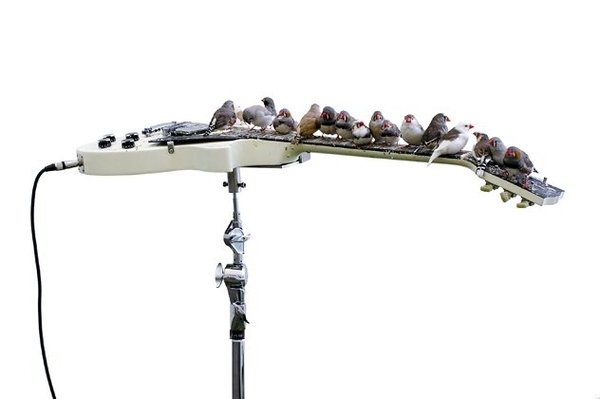Celeste Boursier-Mougenot
dal 26/2/2010 al 22/5/2010
Segnalato da
26/2/2010
Celeste Boursier-Mougenot
Barbican Centre, London
Trained as a musician and composer, the French artist creates works by drawing on the rhythms of daily life to produce sound in unexpected ways. His installation will take the form of a walk-though aviary for a flock of zebra finches, furnished with electric guitars and other instruments and objects. As the birds go about their routine activities, perching on or feeding from the various pieces of equipment, they create a captivating, live soundscape.

The latest commission for The Curve is by French contemporary artist
Céleste Boursier-Mougenot and takes the form of a walk-through aviary inhabited by
40 zebra finches. For his first UK solo exhibition Boursier-Mougenot constructs a
landscape for the birds using bass guitars and Gibson Les Paul electric guitars as
perches, and cymbals as feeders containing water and seeds. As the birds go about
their routine activities, settling on the instruments, plucking strings and pecking cymbals
they create a chance composition. The sounds are amplified to resonate throughout the
gallery. Also included in the installation is a series of videos that featuring close-ups of
hands playing electric guitars. Rather than hearing the sound of the guitars playing we
hear a humming drone produced by the amplification of the video signal.
Boursier-Mougenot trained as a musician and started his career as the composer of
the Pascal Rambert Theatre Company, Paris where he worked from 1985 to1994.
From the early 90s he began makinginstallations for galleries. Working in a variety of
media, including sculpture, video and sound he creates installations which bring
together the audible and the visual. He uses everyday objects and seemingly
unremarkable situations to produce random and captivating soundscapes.
In Videodrones, 2001, Boursier-Mougenot used surveillance cameras to create a sound
piece based on New York street life. By connecting the video output to the input of an
audio amplifier a humming sound was created. The ongoing drone varied in relation
to the amount of light and movement captured by the cameras. Harmonichaos, 2000–
06, is an installation of 13 vacuum cleaners, with harmonicas attached to
each suction nozzle. The vacuums’ motors are controlled by sensors that react to sound
frequencies. As visitors enter the gallery, a microphone in the sensor picks up the
ambient sounds, turning one vacuum on. This starts a chain reaction as other sensors
pick up the sound made by the first harmonica creating a cacophonous sound wave in
the gallery. The effect is an unpredictable orchestration for harmonicas.
Céleste Boursier-Mougenot was born in Nice in 1961. He lives and works in Sète,
France. He is the 2009 recipient of the prestigious Golden David Award for
contemporary art. Recent exhibitions include the 3rd Moscow Biennale of
Contemporary Art, 2009 and solo shows at Pinacoteca, São Paulo, 2009 and Musée
National Marc Chagall, Nice, 2009. His work is in major public and private collections
around the world, including Centre Georges Pompidou, Paris; Museum of Old and
New Art, Hobart, Tasmania; Israel Museum, Jerusalem; San Diego Museum of
Contemporary Art, La Jolla, California and Fonds National d’Art Contemporain, Paris.
Image: from here to ear (detail), 2007. Photograph : Céleste Boursier-Mougenot. © Céleste Boursier-Mougenot. Courtesy Galerie Xippas
With the support of Culturesfrance and the French Ministry of culture and communication and the
French Institute in the United Kingdom
For further press information, photographs or to arrange interviews, please contact
Alex Cattell, Media Relations Officer on 020 7382 6162 or alex.cattell@barbican.org.uk
The Curve, Barbican Art Gallery, London
Opening times: Daily 11am – 8pm and every Thursday LATE until 10pm



